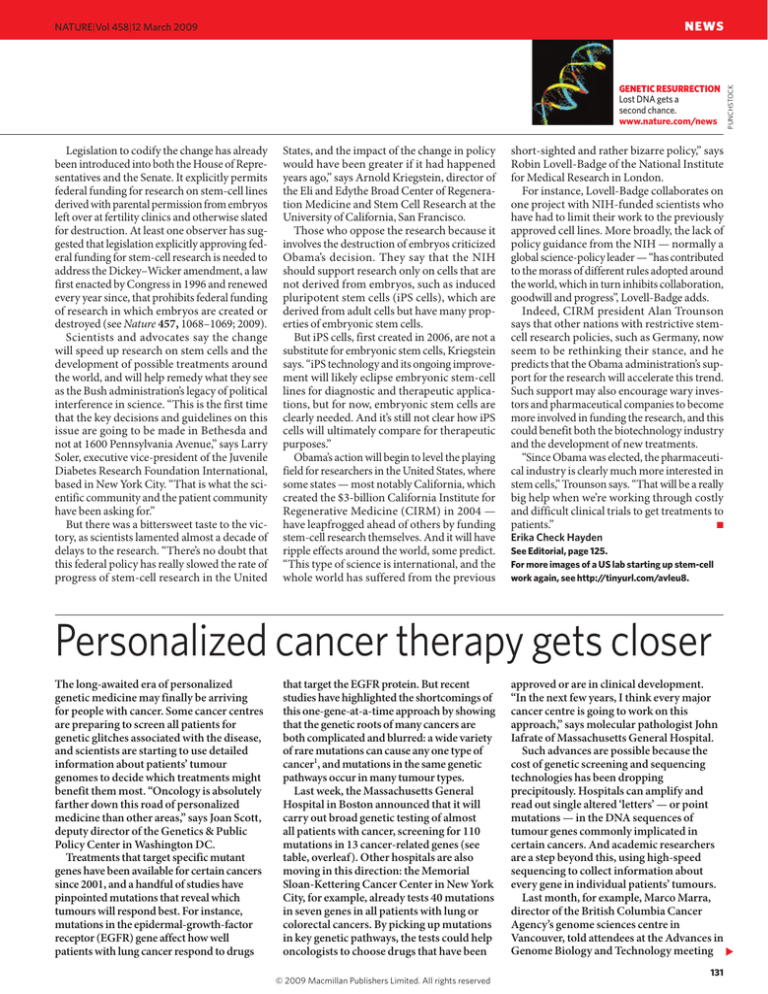
NEWS
NATURE|Vol 458|12 March 2009
Legislation to codify the change has already
been introduced into both the House of Representatives and the Senate. It explicitly permits
federal funding for research on stem-cell lines
derived with parental permission from embryos
left over at fertility clinics and otherwise slated
for destruction. At least one observer has suggested that legislation explicitly approving federal funding for stem-cell research is needed to
address the Dickey–Wicker amendment, a law
first enacted by Congress in 1996 and renewed
every year since, that prohibits federal funding
of research in which embryos are created or
destroyed (see Nature 457, 1068–1069; 2009).
Scientists and advocates say the change
will speed up research on stem cells and the
development of possible treatments around
the world, and will help remedy what they see
as the Bush administration’s legacy of political
interference in science. “This is the first time
that the key decisions and guidelines on this
issue are going to be made in Bethesda and
not at 1600 Pennsylvania Avenue,” says Larry
Soler, executive vice-president of the Juvenile
Diabetes Research Foundation International,
based in New York City. “That is what the scientific community and the patient community
have been asking for.”
But there was a bittersweet taste to the victory, as scientists lamented almost a decade of
delays to the research. “There’s no doubt that
this federal policy has really slowed the rate of
progress of stem-cell research in the United
States, and the impact of the change in policy
would have been greater if it had happened
years ago,” says Arnold Kriegstein, director of
the Eli and Edythe Broad Center of Regeneration Medicine and Stem Cell Research at the
University of California, San Francisco.
Those who oppose the research because it
involves the destruction of embryos criticized
Obama’s decision. They say that the NIH
should support research only on cells that are
not derived from embryos, such as induced
pluripotent stem cells (iPS cells), which are
derived from adult cells but have many properties of embryonic stem cells.
But iPS cells, first created in 2006, are not a
substitute for embryonic stem cells, Kriegstein
says. “iPS technology and its ongoing improvement will likely eclipse embryonic stem-cell
lines for diagnostic and therapeutic applications, but for now, embryonic stem cells are
clearly needed. And it’s still not clear how iPS
cells will ultimately compare for therapeutic
purposes.”
Obama’s action will begin to level the playing
field for researchers in the United States, where
some states — most notably California, which
created the $3-billion California Institute for
Regenerative Medicine (CIRM) in 2004 —
have leapfrogged ahead of others by funding
stem-cell research themselves. And it will have
ripple effects around the world, some predict.
“This type of science is international, and the
whole world has suffered from the previous
PUNCHSTOCK
GENETIC RESURRECTION
Lost DNA gets a
second chance.
www.nature.com/news
short-sighted and rather bizarre policy,” says
Robin Lovell-Badge of the National Institute
for Medical Research in London.
For instance, Lovell-Badge collaborates on
one project with NIH-funded scientists who
have had to limit their work to the previously
approved cell lines. More broadly, the lack of
policy guidance from the NIH — normally a
global science-policy leader — “has contributed
to the morass of different rules adopted around
the world, which in turn inhibits collaboration,
goodwill and progress”, Lovell-Badge adds.
Indeed, CIRM president Alan Trounson
says that other nations with restrictive stemcell research policies, such as Germany, now
seem to be rethinking their stance, and he
predicts that the Obama administration’s support for the research will accelerate this trend.
Such support may also encourage wary investors and pharmaceutical companies to become
more involved in funding the research, and this
could benefit both the biotechnology industry
and the development of new treatments.
“Since Obama was elected, the pharmaceutical industry is clearly much more interested in
stem cells,” Trounson says. “That will be a really
big help when we’re working through costly
and difficult clinical trials to get treatments to
patients.”
■
Erika Check Hayden
See Editorial, page 125.
For more images of a US lab starting up stem-cell
work again, see http://tinyurl.com/avleu8.
Personalized cancer therapy gets closer
that target the EGFR protein. But recent
studies have highlighted the shortcomings of
this one-gene-at-a-time approach by showing
that the genetic roots of many cancers are
both complicated and blurred: a wide variety
of rare mutations can cause any one type of
cancer1, and mutations in the same genetic
pathways occur in many tumour types.
Last week, the Massachusetts General
Hospital in Boston announced that it will
carry out broad genetic testing of almost
all patients with cancer, screening for 110
mutations in 13 cancer-related genes (see
table, overleaf). Other hospitals are also
moving in this direction: the Memorial
Sloan-Kettering Cancer Center in New York
City, for example, already tests 40 mutations
in seven genes in all patients with lung or
colorectal cancers. By picking up mutations
in key genetic pathways, the tests could help
oncologists to choose drugs that have been
© 2009 Macmillan Publishers Limited. All rights reserved
approved or are in clinical development.
“In the next few years, I think every major
cancer centre is going to work on this
approach,” says molecular pathologist John
Iafrate of Massachusetts General Hospital.
Such advances are possible because the
cost of genetic screening and sequencing
technologies has been dropping
precipitously. Hospitals can amplify and
read out single altered ‘letters’ — or point
mutations — in the DNA sequences of
tumour genes commonly implicated in
certain cancers. And academic researchers
are a step beyond this, using high-speed
sequencing to collect information about
every gene in individual patients’ tumours.
Last month, for example, Marco Marra,
director of the British Columbia Cancer
Agency’s genome sciences centre in
Vancouver, told attendees at the Advances in
Genome Biology and Technology meeting
▼
The long-awaited era of personalized
genetic medicine may finally be arriving
for people with cancer. Some cancer centres
are preparing to screen all patients for
genetic glitches associated with the disease,
and scientists are starting to use detailed
information about patients’ tumour
genomes to decide which treatments might
benefit them most. “Oncology is absolutely
farther down this road of personalized
medicine than other areas,” says Joan Scott,
deputy director of the Genetics & Public
Policy Center in Washington DC.
Treatments that target specific mutant
genes have been available for certain cancers
since 2001, and a handful of studies have
pinpointed mutations that reveal which
tumours will respond best. For instance,
mutations in the epidermal-growth-factor
receptor (EGFR) gene affect how well
patients with lung cancer respond to drugs
131
NEWS
▼
on Marco Island, Florida, that his group had
sequenced the whole genome of a tumour
that had spread from one patient’s mouth
to his lung. The group had also used geneexpression studies to compare the activity of
his tumour genes to those in healthy tissue.
They found that the patient had
mutations in a tumour-suppressor gene
called PTEN, and abnormally high
expression of a gene downstream of PTEN,
called RET. This explained why he had
not responded to treatment with the drug
erlotinib, and fits with some earlier studies
suggesting that patients with active PTEN
respond better to erlotinib2. Marra’s team
recommended instead that the patient
be put on a drug called sunitinib, which
inhibits the protein made by RET. The
patient’s cancer subsequently regressed.
“This work illustrates how one can
potentially use next-generation sequencing
technologies to establish the appropriate
course of cancer treatment for individual
patients,” says Eric Green, scientific director
of the National Human Genome Research
Institute in Bethesda, Maryland.
Studies such as Marra’s are being
conducted in many patients to find genetic
traits that could predict how tumours
respond to treatment. And such studies
are likely to increase as the cost of genome
sequencing drops. Rick Wilson, director
of the Genome Sequencing Center at
Washington University in St Louis says that
BURGER/PHANIE/REX FEATURES
NATURE|Vol 458|12 March 2009
Some patients with cancer have gene mutations that can be targeted by specific drugs.
it cost more than $1 million for his centre
to sequence the first tumour genome last
year3. He estimates that the second tumour
genome sequenced at the university cost
$500,000, and projects that this could drop
to $50,000 per tumour by early next year.
Some businesses are finding that a
handful of patients — who may already
be paying thousands of dollars for their
diagnosis and treatment — are willing to
pay this sort of money for cancer-related
genetic information. Last year, for example,
a company called CollabRx, based in Palo
Alto, California, began offering a service
PATIENT CANCER GENES UNDER SCRUTINY
Gene tested (by whom)
Implicated in which major cancers
APC (MGH)
Brain, colorectal, liver, stomach, thyroid
Beta-catenin (MGH)
Brain, colorectal, liver, lung, ovarian, skin
BRAF (MGH, MSKCC)
Colorectal, lung, skin, thyroid
EGFR (MGH, MSKCC)
Lung
FLT3 (MGH, MSKCC)
Blood
JAK2 (MGH, MSKCC)
Blood
KIT (MGH)
Blood, gastrointestinal, germ cell
KRAS (MGH, MSKCC)
Colorectal, lung, pancreas
NOTCH1 (MGH)
Blood
that analyses 15,000 genes, looking at gene
expression, copy number and single-base
mutations in individual patients’ tumours
for between $50,000 and $100,000. Five
patients have used the service, which
aims to determine which available drugs
might be most suitable. Jay Tenenbaum,
the company’s founder and chairman,
calls CollabRx’s approach “personalized
oncology research” because the results of
each patient’s individual analysis are used to
help guide future analyses in other patients.
But because only a few drugs can
currently be selected on the basis of specific
mutations, “you have to be careful with
raising expectations with that kind of
approach”, says Marc Ladanyi, chief of
molecular diagnostics at the Memorial
Sloan-Kettering Cancer Center.
Anna Barker, deputy director of the
National Cancer Institute in Bethesda, is
optimistic that treatment options won’t
stay limited for long. Genomic data being
gathered from patients with cancer should
help researchers to identify the genetic
signatures that correlate with different
symptoms or rates of disease progression —
and hence guide the development of drugs.
Barker predicts that these signatures will
also be used in the future to help doctors to
combine existing drugs to target multiple
genetic pathways and attack specific
attributes of each patient’s cancer. “I’m
very optimistic that we can move in this
direction, and it should be a more costeffective and better way of taking care of
cancer patients,” she says.
■
NRAS (MGH)
Blood, colorectal, thyroid
TP53 (MGH)
Anal, bladder, bone, brain, breast, cervical, colorectal, head and neck, liver,
lung, skin, soft tissue
PIK3CA (MGH, MSKCC)
Brain, breast, colorectal, liver, lung, ovarian, stomach
PTEN (MGH)
Blood, brain, breast, cervical, endometrial, head and neck, prostate, skin
MEK1 (MSKCC)
Lung
AKT1 (MSKCC)
Breast, colorectal, lung, ovarian
Erika Check Hayden
HER2 (MSKCC)
Breast, ovarian
1. Check Hayden, E. Nature 455, 148 (2008).
2. Mellinghoff, I. K. et al. N. Engl. J. Med. 353, 2012 (2005).
3. Ley, T. J. et al. Nature 456, 66–72 (2008).
MGH, Massachusetts General Hospital; MSKCC, Memorial Sloan-Kettering Cancer Center.
132
© 2009 Macmillan Publishers Limited. All rights reserved





